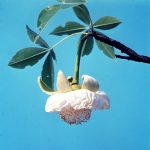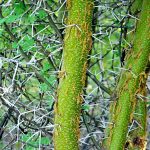TREE LIFE
JANUARY 1990
MASHONALAND CALENDAR
Saturday, 30th December: Extra Mukuvisi Walk. Meet Mark at 1500 hours in Blatherwick Avenue for a walk-in a different area of the Woodland.
Monday, January 1st: HAPPY NEW YEAR
Tuesday, 2nd January: Botanic Garden Walk. Park your car at the Herbarium where we will meet at 1645 hours for 1700 hours.
Sunday 21st January: Our outing this month will be to a most attractive spot with some interesting trees on Lindy Riley’s farm in the Norton area. This will be an own cars outing and we plant to meet at Lindy’s house at 1030 hours.
Saturday 27th January: Walk with Mark Hyde. Phone Mark at home on 701023 before Friday for venue and time – see Tree Life No. 118.
MATABELELAND CALENDAR
Monday 1st January: Our traditional New Year’s lunch at Norma Hughes’ home, 10 Gary Owen Way, riverside, from 1130 hours. Bring chairs, food, drink and be merry.
Sunday 7th January: To Balla Balla Ranch with some special trees. Meet at Hotel Rio at 0830 hours. The route will be way out on the Johannesburg road. All day, bring lunch
Sunday 18th February: Now that there are leaves again, we are going to Richmond Park (just beyond Falls Road Motors) on the Victoria Falls Road to see the varied countryside in 1500 acres – and to have our AGM. Meet at Falls Road Motors at 0830 hours. Morning only.
Sunday 18th February: An extra for those interested. The girl Guides want us to name their trees around the buildings in Rowallan Park (just before the MOTHS Shrine), Matopos. We will make this an all day outing, with the proviso that it will not be an ordinary outing but a working party (in an attractive area) to identify and label trees. Bring lunch and meet at Retreat at 0830 hours.
MATABELELAND NOTES
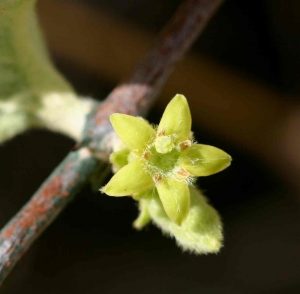
Tapiphyllum velutinum. Photo: Bart Wursten. Source: Flora Of Zimbabwe
On Sunday December 3rd we went to the Eastern Edge of the Matopos, to Mr. Roy Stevens’ Farm, Shumba Shava Mkulu. A most worthwhile visit, to an unspoilt area, with an amazing variety of species and most magnificent views. We identified some 120 species. Of note were Acacia ataxacantha, A. sieberiana, (no other Acacias seen), Acokanthera rotundata, (S. schimperi), Albizia tanganyicensis, Allophylus africanus, many Brachylaena rotundata, Brachystegia glaucescens, the mountain Acacia, Calodendrum capense, with extra large leaves, Catha edulis, widespread, Combretum zeyheri with its large fruits, Commiphora marlothii, Cussonia arborea and C. natalensis for contrast, Elephantorrhiza goetzei, frequent and with big prominent fruits, Erythrina lysistemon, unusual here as the local species is E. latissima, Euclea racemosa very shiny, Euphorbia cooperi and E. ingens, Ficus verruculosa, the wart fig, but no warts to be seen, Halleria lucida flowering, Heteropyxis dehniae, widespread, Hexalobus monopetalus, fruiting, Lantana camara, too many, flowering, Margaritaria discoidea (Phyllanthus), Maytenus heterophylla subsp. puberula, the small leaved Matopos subspecies, Maytenus undata, bloomless, Ochna schweinfurthiana, Olinia vanguerioides, a very local rarity, Pavetta gardeniifolia (P. assimilis), P. eylesii, common in the rocks, Psydrax livida (Canthium huillense), Securidaca longepedunculata with one violet flower, Sericanthe andongensis (Nerosea) Steganotaenia araliacea, Strychnos cocculoides, S. madagascariensis and S. matopensis,
Tapiphyllum velutinum, the red brown under bark showing well, Tarenna neurophylla,, T. zimbabwensis (Enterospermum rhodesiacum), Trema orientalis, the Elm family species with leaf margin finely serrate, right round, Vangueria infausta, mostly fruiting, Vepris reflexa, Vitex payos. Also some half dozen unidentified species. There is a good deal more to be seen there, I feel, but it was a wonderful introduction.
C. Sykes Hon Secretary.
BOTANIC GARDEN WALK : 5TH DECEMBER 1989
This month Bob Drummond took us around the section containing trees of economic importance. He also gave us interesting facts about the Botanical Gardens as we made our way there. None of the planted trees in the Gardens is older than 25 years and the Acacia abyssinica planted in an avenue leading from the Herbarium are only about 10 years old. We stopped at the fig like Milicia excelsa (Chlorophora excelsa) which is in the MORACEAE family. In Zimbabwe these trees grow in Gona re zhou and on the Rusitu valley (Swahili name – Mvula), while in East Africa they are in demand as a heavy, all purpose timber. We skirted the lake (apparently 25ft deep in the middle) and enjoyed the light on the pale green bark of the A. xanthophloea. Our first stop in the economic section was at an Albizia versicolor. These trees can, in some years, be responsible for the death of hundreds of cattle as there are high winds in September which blow down the unripe, poisonous pods. A. tanganyicensis has recently caused the death of goats around Gwanda. Next came Leucaena leucocephala – ‘the wonder tree’ growing here as a multi stemmed, rather bushy tree. Apparently it prefers higher temperatures, high rainfall and well drained sandy soil. The tree is nitrogen fixing, quick growing, can provide useful timber and the shoots and green pods make a high protein forage. The climber
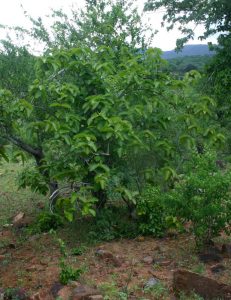
Strophanthus kombe. Photo: Bart Wursten. Source: Flora of Zimbabwe.
Strophanthus kombe was still in flower with its trailing tendrils. The poisonous seeds are collected commercially in Malawi and Mozambique for medicinal purposes. After tea and coffee bushes, and the European olive, Olea europaea subsp. europaea, which does not grow here, we came to Bixa orellana, (family BIXACEAE, related to FLACOURTIACEAE). This has chestnut or hedgehog like pods which split in two to reveal the seeds nestling in each half. A butter yellow dye is prepared from the seeds. This has been planted by the Roads Department as an ornamental shrub. The pomegranate (family PUNICACEAE, related to MYRIACEAE) was looking luscious with its shiny leaves and red fruit (Song of Solomon, Kim)! We glanced at cotton, sugar cane, sisal and a large tree covered with pink flowers, No. 4706 – Bob was going to look it up. Jatropha curcas, the black physic nut grows on the ruins around Rusape and so was presumably introduced by the early inhabitants of the country. We looked at the real rubber tree, Havae brasiliensis which has trifoliate leaves, each leaflet having a drip tip and resisted the urge to try a pen knife on the trunk. There were no raisins this time on the raisin tree, Hovenia dulcis (FLACOURTIACEAE) but we admired its foliage. The leaves are serrated, 3 veined from the base and have pink tinged petioles. The jojoba bush, Simmondsia chinensis, has grey green leaves from which an oil is extracted. This isused in Israel in lubricants and as a substitute for sperm oil. There were green fruit on Psidium cattleianum, the strawberry guava. (I know it as the Chinese guava – it grows wild in the Vumba). The Surinam cherry or rosella bush, Eugenia uniflora, had ripe fruit (bright orange and corrugated) and flowers present. Both of these fruits make a very good jelly. The carob tree, Ceratonia siliqua had flower spikes on it. This has bean like pods from which a meal is made, which in Spain and Portugal is incorporated into baby food (it is thought to prevent diarrhoea). Finally, we looked at the real kapok tree with its green trunk and long green pods. Our thanks to Bob for such an informative walk. No. 4706 is Malpighia glabra, the Barbados cherry. The bark is used for tanning hides, while the fruits are rich in ascorbic acid.
–Tessa Ball
NYARUPINDA CATCHMENT
There is so much to write for November. Details of the climate are part of the natural history and we have had 30mm rain so far this month and the temperature has been around 30 degree in the day time. In this pitiless heat nymph colonies of a 1cm long insect called Ptyelus grassus do their best to rain for us. They live on Lonchocarpus capassa. Similar rain bugs live on Weeping Wattle (Peltophorum africanum), this tree has cheerful yellow flowers now. Today for the first time, we found a group of full-grown Rain Trees (Lonchocarpus capassa) so laden with pods as to be almost touching the ground. Every spray of flower has set 30 or more finely velvety pods. What a fragrant and beautiful sight awaits us next September and October. There is a carpet of recently fallen flowers beneath tall stately Albizia amara sericocephala, widely spreading Acacia sieberiana and a glade of well-spaced Dichrostachys cinerea. Acacia polyacantha and Brachystegia boehmii are exceptionally floriferous. The man who thatched our house warned us about the damage caused by Mufuti flowers. We do not know whether the damage is physical or chemical. The sticky flowers may be corrosive, for example a tin always used for sugar shows signs of being eaten away. We have found that the long handled pool brush is an excellent tool for removing Brachystegia debris from the grass roof. Mention of the pool reminds me that one day we found a centipede in the leaf trap and the following day there was a Barred Centipede Eater in the water. This is a snake. A tree we hope to find in this botanists’ paradise is
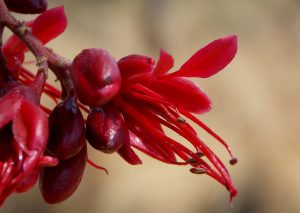
Schotia brachypetala. Photo: P. English. Source: Flora of Zimbabwe.
Schotia brachypetala. The Nyarapinda Catchment has the drier types of woodland, anthills and river banks to suit this species. This tree weeps nectar in September or October, which attracts insects and birds. There is a fine example of this tree close to the Institute of Blackfords by College. We shall search for Huilboerboom now that we know what it looks like. It is Ochna flowering season and gambleoides has done it! One tall limb has produced a terminal cluster of flowers. This was found yesterday (21.11.89), unfortunately the yellow petals had gone. 2 or 3 out of a possible 5 green carpels side-attached to the yellow receptacle have developed. The remainder are just green pimples. Within the 5 pink flashy sepals a ring of stamen filaments and single stigma can be identified. The shrub Ochna is in full flower at ground level. Ochna schweinfurthiana has copper-coloured leaves and flower buds at the moment. The red lily – fireball (Scadoxus multiflora) pops up unexpectedly and contrasts with the pale clustered flowers of Xerophyta equisetoides which is suddenly there in speckled shade on stoney slopes. Combretum species in this area have almost finished flowering when the Terminalias begin to flower. Some white spikes of T. sericea are opening and we must observe the giant spikes of T. mollis. Pleurostylia africana shows minute flower buds amidst its drooping leaves – the chameleons like this tree while the white blossoms attract insects. A Zanha africana grows next to Pleurostylia africana, the latter is said to have Aphrodisiac properties. How secretive the former is about flowering, it passed unnoticed. The birds were not interested in her orange wild apricots which are quite appetising; these were found quite by chance, just beyond the clothes line. The bright orange fruits of Olax obtusifolia are very short-lived. It is strange that there are flowers and ripe fruits and it is rare to find the transition i.e. green fruits increasing in size. Perhaps the hottest of driest days cause pre-harvest drop. Beware if you bite into these tempting fruits (just to see what is inside) because they contain colour matched maggots. Many parasitized fruits remain on the tree from year to year. This can be an aid to identification. The mystery tree (with star like flowers) growing on the anthill high above the lily pool is not Aphloia theiformis but
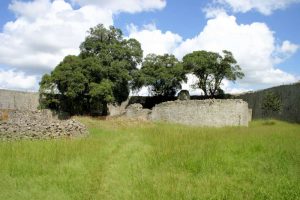
Mimusops zeyheri. Photo: M. Jackson. Source: Flora of Zimbabwe
Mimusops zeyheri. Identification was assisted by reference to Robert B. Drummond’s tree book produced by the NRB, see pp 180-181. There is no sign of milk in this tree at present and no fruit has set. Mimusops could mean ‘mimic like’ or ‘ape face’ because of the shape of the flowers. Bob suggests that its name is derived from the fact that the plant is very like a number of species unrelated to it.
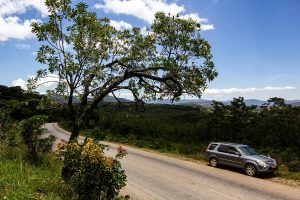
Protea gaguedi. Photo: Bart Wursten. Source: Flora of Zimbabwe
Close to Mimusops zeyheri there is a stemfruit Bequaertiodendron magalisamontanum, Its specific name indicates where it was found when first collected. About 160 years ago Carl Zeyhe collected plants in the Magaliesburg mountains and might have nearly got lost like I did when revisiting a certain tree. The source of the Nyarupinda are many and in undulating country. It seemed a good idea for my friend to lead my horse whilst I made my way downstream on foot. A rendezvous was agreed upon. On the way I passed the translucent fruits of Ximenia americana and new and old fruits together on a Combretum hereroense. There was no time to look at the unusual buds that called. It dawned on me that the stream I followed was not the one which led to the tree. Where was I, and where was my transport? I retreated my steps to find the correct stream, still no tree. I waited, listened, called, no one heard. Then voices came from an unexpected direction. Following the sound I clambered up over a ridge and there down below saw my companion with the two horses. Not at the chosen rendezvous, but then, all’s well that ends well. About 50 species of trees here are flowering in November, few are as well displayed as Protea gagueda.
The Festive Season has arrived and CANDLES are part of it. I must stop writing and dash off to collect Ximenia Americana for Tom Muller. The birds or the village children will probably have got there first, but I am hopeful that they have left the kernels, so that all the Herbarium Staff can witness a Ximenia Candle for Christmas. I hope Stephen can made the oily seeds burn down the wire.
-Benedicta Graves.
CLEVELAND DAM : DECEMBER 1989
I must confess that I was very sceptical when I collected my little card to play “Tree Bingo”. This game did seem a bit simplistic for a morning’s entertainment. But I am now completely converted. Tree Bingo works at keeping interest high and is very conducive to learning trees in a relaxed atmosphere. Dick and Maureen had prepared the cards on the lines of the game as initiated by the Bulawayo Branch (it was their idea and they play it often). Each person had a list of 10 trees from the field card, all trees occurred in the area. Phil then headed the walk and called out the names of those trees that he noticed as we went. What did we learn? We suddenly have to consolidate our knowledge – yes I needed Peltophorum africanum but I was not going to get it here amongst the rocks, we must try to lead Phil off to the sandy flats somewhere. Knowing that it was not going to be here is an important piece of information. Then of course, it was interesting to see what Phil walked past. We ignored a magnificent Ficus sur and Dombeya rotundifolia, both of which were on my card. I know of many people who learned Steganotaenia because as Phil walked over them there were cries of “look there’s another one that we’ve just passed’ until everyone with Steganotaenia on their card knew exactly what it looked like, although in the end it was never called! Many congratulations to Tessa who won the return ticket to Chitungwiza in the new articulated omnibus!
TREE PLANTING DAY : DECEMBER 1989 :
For many years now we have planted trees on Tree Planting Day. The success of the occasion is not in how many trees we plant but in how many survive or in how much is learned. This year we tried a different approach at the Mukuvisi Woodlands. The 20 junior school children were led off into the woodland to collect seeds of musasa and mufuti. We had a fun time finding seeds. Some were square, some had a small root, in others the seed coat had split off showing the cotyledons. We also collected seeds that had been eaten by beetles and seedlings that were dying of exposure. Back in the classroom we looked at our collection and emphasised the fact that seeds are dormant (we can throw them into the cupboard for the holiday just like teddy and when we look again they are still there, if they have not been eaten). We decided to keep our seeds till next term when we can plant them under the watchful eye of a teacher and then care for them all the year until next Tree Planting Day. In this way I believe children develop a greater responsibility for trees. We shall see how well it works!
MUKUVISI WOODLAND NOTES
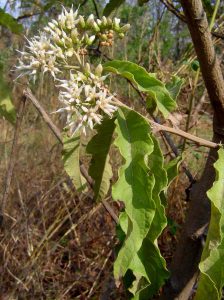
Vernonia amygdalina. Photo: Bart Wursten. Source: Flora of Zimbabwe.
Following the formation of the Association it became possible to apply good conservation procedures. Prior to this, a devastating hot burn swept the whole woodland annually, generally at the most damaging time of the year, August to October. In 1981 we commenced a cool burn regime, creating a mosaic effect, to neutralize the ravages of the annual hot burn. At this time the flora of the woodland could be described as fire-interrupted climax, there was very little obvious succession, except annually in the understorey vegetation, and this was dependent on both severity of the fire and rainfall, sometimes groundwater availability. Fire was not the only diverse factor, degradation at the hand of man ensured that all tree orchids, aloes and succulents in general had been extirpated by those misguided people who destroy nature in a sometimes vain attempt to transplant it into their gardens. Selective wood extraction meant that many species were either completely wiped out, Brachystegia boehmii or pushed close to the brink, Dombeya, Ficus sp. Ochna if these specially desired plants were also fire tender as in the case of Pterocarpus angolensis, in effect their fate was sealed. Survival became impossible, ground orchids and flame lilies were ripped out as soon as they appeared above ground level. Our early policing efforts through the voluntary warden system were immediately effective. It took a little longer for the really beneficial results of fire control to be seen. However, once we had the situation well under control, it became positively exciting, nearly every month we were finding either new species or re-records, or noting interesting distribution,. The success of Syzygium cordatum spreading along the Makabusi River line, Pterocarpus angolensis extending itself into the eastern game area, forming near pure stands of saplings where there had been only a handful of known survivors in the whole area. This tree had also been hacked about for muti, so before protection, it had suffered threefold. Celtis africana was more timid, it only seemed to creep out of its few fireproof refuges, but its presence as sturdy young saplings where previously it would have found survival impossible was quickly noted. My record of such anecdotes is vast, I have said enough to say how interesting was this exercise, and how grateful we were to see such rapid results. Then, of course, in 1983 game stocking commenced and once again there was a rapid series of changes leading in fact to substantial re-orientation of the processes of plant succession. The effects of game stocking have been very profound and I propose to deal with this in a later issue of Tree Life. Following the publication of Meg’s guide and its attendant checklist, as Kim said, when he spoke at the ‘launching’ a checklist is a continuous process. It will, I trust, not be considered impertinent on my part to immediately come up with further species not on Meg’s list. These are all plants I have notes during the past few years. I am not going back in time. We have lost many which were on Douglas Aylen’s list: Aloe excelsa; Ximenia americana; Ficus ingens; F. salicifolia; Rhamnus prinoides; Zanha africana; Terminalia stenostachya; Heteromorpha trifoliata; Tricalysia angolensis; Vernonia amygdalina. These are all naturally occurring, I have not cheated by including any planted in the demonstration zone.
George Hall. 10.12.89
DICK HICKS CHAIRMAN


